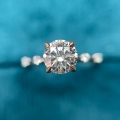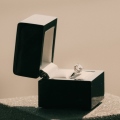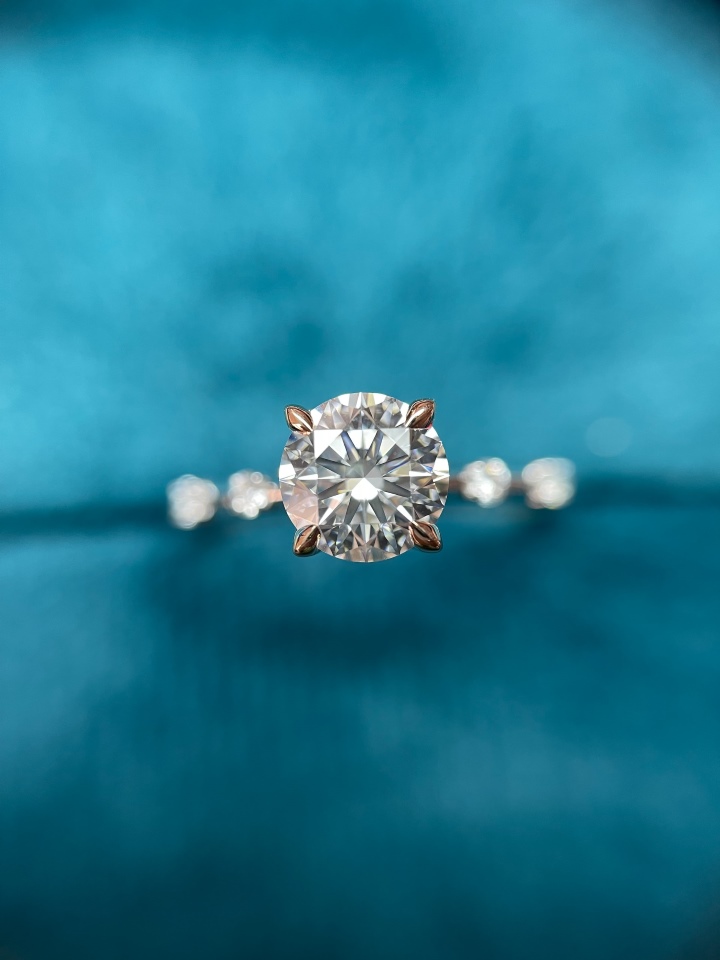Someone Else Says There's Only 4 C's Though!
Clearly, I’ve added a 5th "C" which, in my opinion, is the most important aspect... Cost.
1. Colour
Colour is a very important factor to carefully consider when choosing a diamond. Colour is measured on an alphabetic scale which starts at D and continues to Z, grades A-C are no longer used to avoid confusion with pre-1907 standards. Diamonds graded D-E-F are considered to be “collection colour” as they’re a very clear white in colour. Customers who can afford and desire the finer things in life are often attracted to this colour range. Just remember that the whiter the diamond, the higher the cost. Diamonds graded G-H-I are also very white and typically will not present any visible yellow once set into a ring. Diamonds graded as "I" colour can sometimes present little hints of yellow depending on the stone. The hue of a Diamond is referred to as fluorescence. With diamonds graded lower in colour which are well cut, fluorescence can actually enhance the colour. J-K-L grades and lower will show a clear presence of colour. Yellow as its most common colour to see in a diamond but, keep in mind, diamonds do come in all colours like grey and brown. When a diamond shows deep colour, it’s referred to as fancy colour and there are a wide range of colours and if they’re deep and rich in colour, can be very expensive. We’ll continue with colour in questions and answers.
2. Cut
Cut is arguably the most technical aspect of a diamond as it refers to the proportions the raw diamond is left with after it has been ground and polished. The cut greatly affects how the stone reflects light and how brilliant it appears or the colour it produces. Many diamonds are not cut well and will lack the lustre and shine that they’re capable of displaying. When working from a raw uncut gem, a diamond cutter typically will work to maintain the highest carat weight rather than cutting the diamond proportionately for maximum brilliance. In the industry, there's several competing standards for assessing the quality of a diamonds cut. For example, GIA uses a scale based on their history of apprasials ranging through Excellent, Very Good, Good, Fair, and Poor. The AGS standard grades diamonds on a scale from 0-10 with an associated rank: Ideal (0), Excellent (1), Very Good (2), Good (3-4), Fair (5-7), Poor (8-10). Beyond their shape, Many syles of cuts have also earned names for the typical proportions and how light behaves when it enters and exits the diamond. Princess, Asscher, King, Magna are just a few names for common styles of cuts. When you make your appointment with us, we will set aside time to educate you on how important the cut of the stone is while showing you several examples so you may adequately compare the range of cuts available.
3. Clarity
Clarity refers to the natural imperfections of inclusions or blemishes that are contained within a diamond. Inclusions are most often white feather like makings or black carbon deposits which failed to fully form into diamond. The most widely used standard for grading clarity is the scale developed by the GIA wherein diamonds are graded on an 11-step scale from Flawless, Internally Flawless, Very Very Slightly Included 1 & 2, Very Slightly Included 1 & 2, Slightly Included 1 & 2, Included 1, 2, & 3. Typically, the clarity of a diamond plays a big role in the price but a smaller one in the appearance of the diamond. We always take the time to discuss clarity with our clients and how not to be coerced into buying a diamond with high clarity when other aspects may be more important. It's not uncommon to happen upon two diamonds graded at the same clarity which somehow have a $1000 difference in price. One diamond may be a really strong "SI2" that just missed the "SI1" grade while the other my have squeezed into "SI2" from "I1". Come visit our showroom and we'll show you how to purchase the absolute best diamond for your budget.
4. Carat
This is a specialized unit of mass for the measurement of a gemstone which was ratified globally in 1907. One carat is equal to 200mg so, your 2.5ct center stone will weigh 500mg. As you've probably already guessed, the more carats a diamond has, the larger and more expensive it will be. When you shop with a diamond wholesaler like National Jewel Creations, we can help you beat the typical retail markups and net you a larger carat diamond without busting your budget. Here’s how we make that possible: Compare these two diamonds that are the same price. 1.20 carat SI2 G – Larger, with some possibly visible inclusions, near colourless. 0.90 carat VS2 G – Smaller, with fewer possibly visible inclusions, near colourless. Which would you choose? In this instance, 90% of buyers will go for the 30% larger diamond as depending on the stone, the larger slightly lower graded SI2 stone will be carefully selected from our suppliers to be as brilliant and eye clean as possible to give you a better result for your design.
5. Cost
As you increase the desireable specifications of each of the 4 C's individually, the higher the overall cost will go. Without understanding how the combination of the 4 C’s relative to eachother constitute a single diamonds value, you're not able to fully assess what it is you're buying. Imagine if you went to buy a car and they didn't tell you how much power it makes, how well it handles, or it's ability to accelerate and decelerate? Knowing these attributes individually won't help you form an opinion of it or give you a means by which to compare it with other cars. When you book an appointment with National Jewel Creations for your wedding and engagement jewellery, we will assist you in finding the diamonds that not only fit your budget but also maximizes all the characteristics you desire.
















